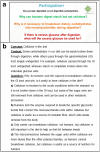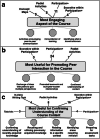Collaborative Active Learning Activities Promote Deep Learning in a Chemistry-Biochemistry Course
- PMID: 34457737
- PMCID: PMC8368399
- DOI: 10.1007/s40670-020-00952-x
Collaborative Active Learning Activities Promote Deep Learning in a Chemistry-Biochemistry Course
Abstract
Currently in higher education, there is a move towards providing more student-centred learning experiences, where students are actively involved in the learning process. To promote learner engagement and communication between peers, many educators utilise collaborative active learning activities. This study aimed to demonstrate that an active learning curriculum developed for a Chemistry-Biochemistry unit, allowed students to gain a deep understanding of the content, while developing key academic skills. In each face-to-face session of the Chemistry-Biochemistry unit, students participated in collaborative active learning activities including Participation+ and a variety of Padlet activities. The students were also challenged to develop their written communication skills, by taking part in a formative In-Class Writing Task. Survey results indicated that the active learning curriculum provided an engaging, interactive environment that was conducive to the students developing an understanding of the course's underlying concepts and developing key academic skills. The students communicated their deep understanding of the content verbally during active learning activities and in writing during the In-Class Writing Task, written assignment and final exam. Students who consistently communicated deep knowledge of the content during the In-Class Writing Task achieved high marks on the summative written assignment, final exam and unit total. This study clearly demonstrates that the active learning curriculum employed in the Chemistry-Biochemistry unit provided a collaborative and engaging learning environment, where many students developed a deep understanding of the content and acquired the skills to communicate their knowledge both orally and through written communication.
Keywords: Active learning; Biochemistry; Chemistry; Collaborative learning.
© International Association of Medical Science Educators 2020.
Conflict of interest statement
Conflict of InterestThe authors declare that they have no competing interests.
Figures




Similar articles
-
Learning-oriented assessment increases performance and written skills in a second year metabolic biochemistry course.Biochem Mol Biol Educ. 2016 Jul 8;44(4):412-20. doi: 10.1002/bmb.20962. Epub 2016 Mar 23. Biochem Mol Biol Educ. 2016. PMID: 27006292
-
Implementing goals for non-cognitive outcomes within a basic science course.Acad Med. 2002 Sep;77(9):931-2. doi: 10.1097/00001888-200209000-00035. Acad Med. 2002. PMID: 12228102 Review.
-
Medical Students' Professional Development as Educators Revealed Through Reflections on Their Teaching Following a Students-as-Teachers Course.Teach Learn Med. 2017 Oct-Dec;29(4):411-419. doi: 10.1080/10401334.2017.1302801. Epub 2017 May 12. Teach Learn Med. 2017. PMID: 28497991
-
Student and educator experiences of maternal-child simulation-based learning: a systematic review of qualitative evidence protocol.JBI Database System Rev Implement Rep. 2015 Jan;13(1):14-26. doi: 10.11124/jbisrir-2015-1694. JBI Database System Rev Implement Rep. 2015. PMID: 26447004
-
Engaging Students and Faculty in a Collaborative Learning Environment: Let's Check-In!Nurse Educ. 2023 Mar-Apr 01;48(2):98-102. doi: 10.1097/NNE.0000000000001284. Epub 2022 Sep 6. Nurse Educ. 2023. PMID: 36066558 Review.
Cited by
-
Implementation of a Web-Based Educational Intervention for Promoting Flipped Classroom Pedagogy: A Mixed-Methods Study.Med Sci Educ. 2022 Dec 24;33(1):91-106. doi: 10.1007/s40670-022-01706-7. eCollection 2023 Feb. Med Sci Educ. 2022. PMID: 37008440 Free PMC article.
References
-
- Danker B. Using flipped classroom approach to explore deep learning in large classrooms. IAFOR J Educ. 2015;III:171–186.
-
- Felder RM, Brent R. Active learning: an introduction. ASQ High Educ Brief. 2009;2(4):1–5.
-
- Gier VS, Kreiner DS. Incorporating active learning with PowerPoint-based lectures using content-based questions. Teach Psychol. 2009;36(2):134–139. doi: 10.1080/00986280902739792. - DOI
LinkOut - more resources
Full Text Sources
